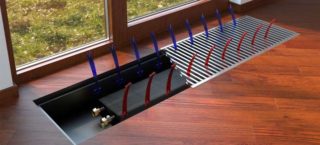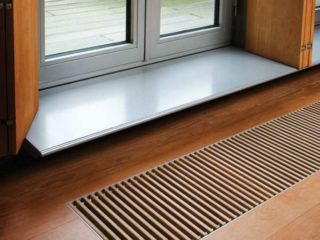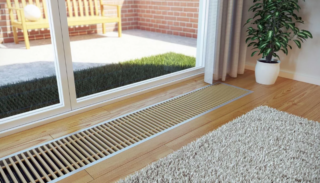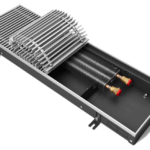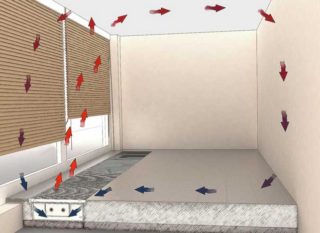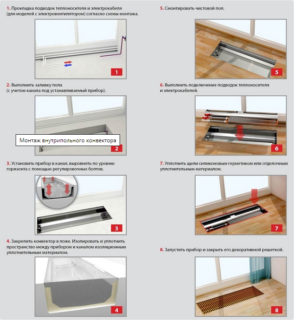Floor heating radiators built into the floor are increasingly being used in modern houses and apartments. It is advisable to install such batteries in rooms with panoramic windows, for example, in private buildings, conservatories, glazed terraces and company offices. In addition to the main heating function, they help create a thermal curtain that prevents the entry of cold air from the windows. Before installing a battery for heating in the floor, it is worth evaluating the advantages and disadvantages of such radiators, as well as studying their design features.
Design features of built-in radiators
The standard radiator in the floor in appearance resembles a pencil case, covered with a grill on top, inside which there is a heating device. The built-in battery consists of a heater, a housing and a protective panel that covers the structure. In order for the heat to be distributed evenly, such radiators are supplemented with fans, placed inside the screed and installed at the floor level. The heating process occurs due to convection, for this reason, structures of this type are called built-in convectors.
Any battery in the floor under the window works on the same principle. Cold air passes down through the grill, heats up and rises up back. There is a separate category of radiators of this type, during which convection heating occurs naturally. Such devices are considered more effective, since they are able to warm indoor air faster. Heating grilles are usually made of metal or wood and painted in different colors.
The built-in radiator works on the principle of air circulation, so it is better to install it near doors and windows. Inside these batteries is a relief valve, which helps to increase the efficiency of the system and maintain the desired temperature.
Advantages and disadvantages
All batteries built into the floor have their pros and cons, having studied which you can determine the type of radiator. The list of benefits includes a long service life, which allows you not to think about repairing or replacing the battery for a long time. Built-in radiators are characterized by good performance and do not cause problems during operation.
Heating appliances are quite reliable and belong to the category of environmentally friendly equipment. Thanks to the optimal design, such a battery will not spoil the interior and interfere with furniture placement, as it is almost completely hidden from prying eyes. Also, the floor and built-in radiator makes it possible to install panoramic windows of any type in the room.
Built-in batteries have their drawbacks:
- the need to increase the height of the ceilings so that the installation goes smoothly;
- high price in comparison with standard models of floor or wall type;
- with a ceiling height of more than three meters, it is better to use wall structures;
- installation difficulties;
- increase in electricity charges if the battery has the option of forced convection;
- ability to distribute excess dust.
It is best to install built-in heating radiators in the process of building a house or major repairs.The reason is a complicated installation, since the batteries must be connected using the channel laid inside the floor.
What rooms is suitable
Radiators for heating, built in the floor, are suitable for the implementation of non-standard design solutions in houses or apartments. This is a good choice for those who want to install panoramic windows in the room or make a redevelopment, after which the installation of standard batteries will be impossible. Most often, such situations arise when the walls to which the radiators are attached are made of lightweight materials and are not able to withstand the heavy weight of the heating batteries.
Often such batteries are installed in shops, offices, hotels and other common areas, since it is necessary to install glazed windows and panoramic windows. Thanks to the stylish appearance, modern radiators often become an element of decor, their aesthetic design allows you to implement any projects, even in small apartments. The versatility of built-in batteries makes them a great option for anyone planning to save room.
Varieties of floor-mounted radiators
Floor recessed batteries can be divided into two main types: electric and water. Electrical structures are equipped with closed heating elements in which steel or copper plates are installed. Such radiators are manufactured taking into account the safety requirements for electrical appliances and equipped with fuses that protect them from failures. This is an ideal choice for houses where there is no connection to central heating. Water-type radiators are metal tubes with plates, they are connected to the heating system using pipes. As the starting material for them, copper, steel or aluminum is used.
- Water
- Electric
In stores, there are radiators with forced and natural convection of the two-pipe or four-pipe type, which can be used both for heating and for cooling rooms. In the first case, the heat exchanger is connected to the heating and cooling system, in the second there are two heat exchangers associated with one of the necessary systems. These are more effective, but at the same time quite expensive radiators. A good choice is models with the option to supply fresh air, which passes through the built-in filters and, after heating, is distributed indoors.
If the floor of the room is curved, the problem can be solved by ordering built-in radiators of an angular type or with the required radius of curvature. A good option would be devices with heat exchangers on hoses that allow you to pull out the device and hide it back if necessary.
What to look for when choosing
Before buying a floor heating convector, which is built into the floor, you need to pay attention to the size and power of such equipment. You will need to immediately decide: you need to install a fan for forced convection or natural will be enough.
To choose a built-in battery, the following factors are considered:
- Pressure in the heat system. If the built-in radiator is installed in an apartment building, the pressure level must be taken into account. These data can be obtained from the housing department or from the employees of the management company before choosing the right model. Such a battery must cope with a pressure of up to 15 atmospheres.
- Type and parameters of thermal carrier. When installing a floor radiator in a private house, any coolant is suitable, since the owner can control his condition and temperature himself. Before installing in a multi-storey building, you need to consider the filling of the battery and its characteristics.
- Diameters for connection and type of heating system.Most radiator models can work in two-pipe and single-pipe heating systems, more detailed information needs to be specified upon purchase.
Built-in radiators may be the only source of heating in the room. They cannot be combined with other batteries and radiators to avoid problems.
Tips for installing built-in batteries
After making the decision to install the built-in battery in the apartment or house, you need to draw up a project and indicate all the necessary data, including the location, size of the structure and its performance. A standard radiator installed in the floor under the window must be mounted according to the instructions. First of all, pipes are laid for the thermal carrier in the process of pouring screed on the floor covering. When the room is ready, it installs the strobes where the pipes are placed, and prepare a niche for the building. It should be 5 mm larger than the radiator box, taking into account the width and length, if the connection is end-on, and 10 mm if it is lateral.
After installing the heating battery itself. At the installation stage, it is important to position the structure at arm's length so that it cannot protrude beyond the floor surface. The nozzles are connected to the pipes for supplying a thermal carrier and fix the joints. To test the system, test it and mount the external grille at the final stage.
The power and size of the device are calculated taking into account the height of the ceilings, the dimensions of the windows, the average air temperature in winter and other parameters. For 1 square. m of area should be at least 100 watts of radiator power.
